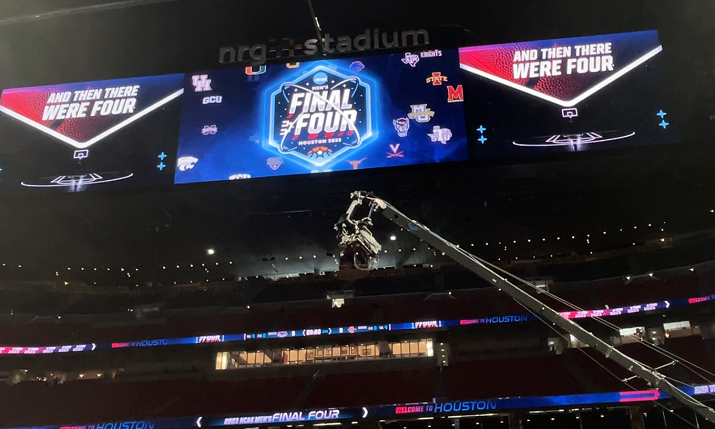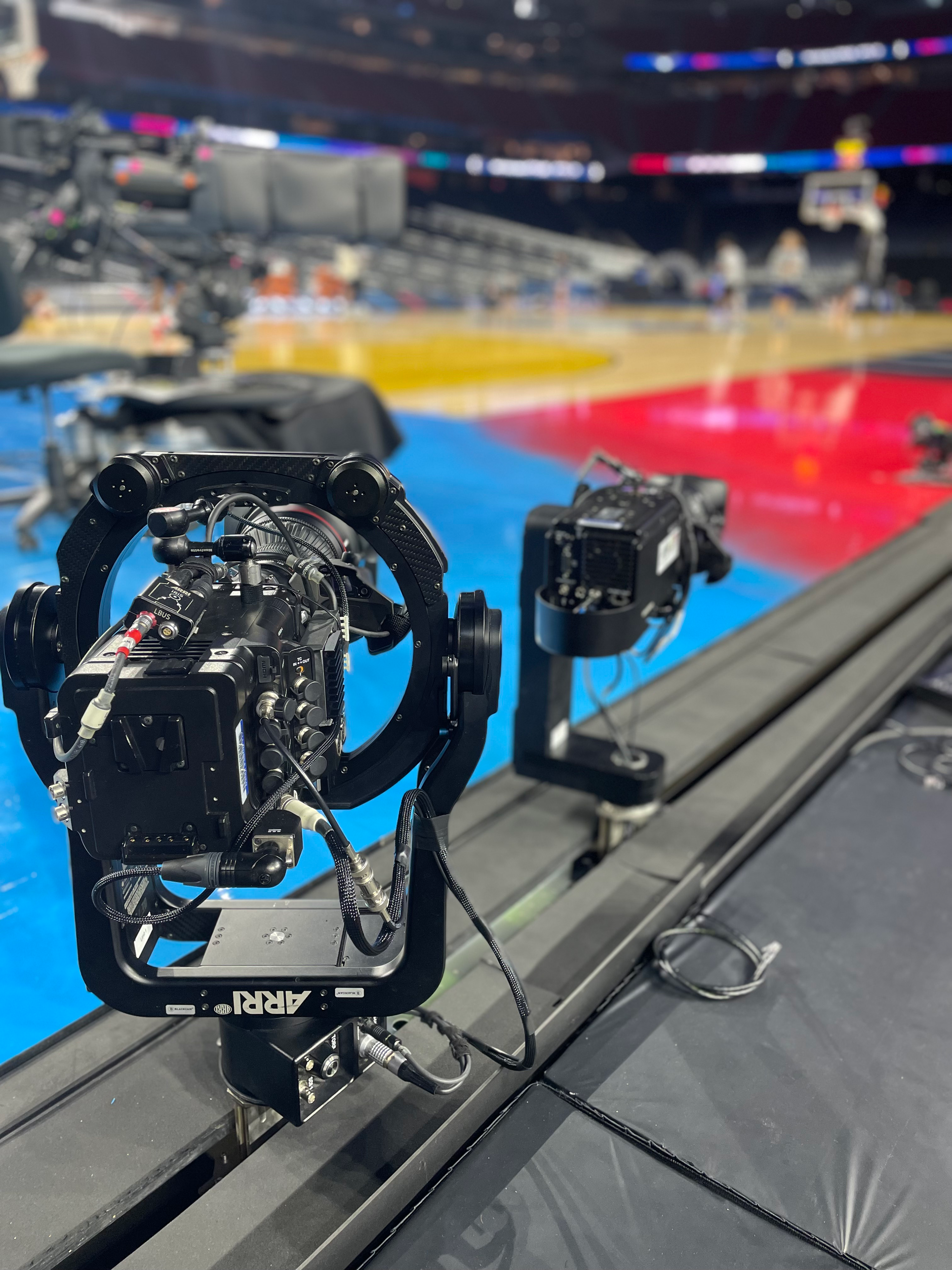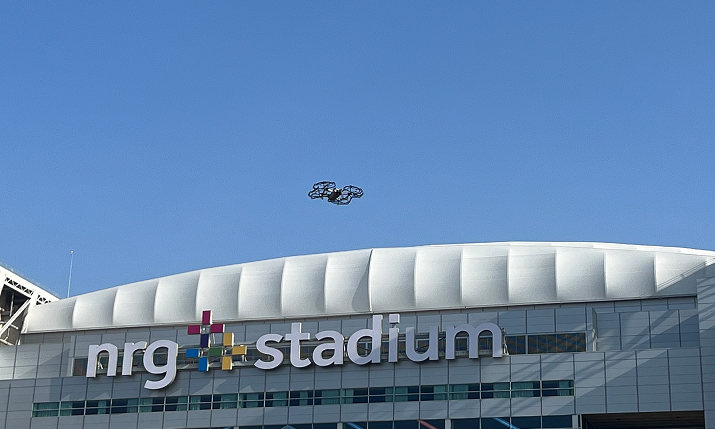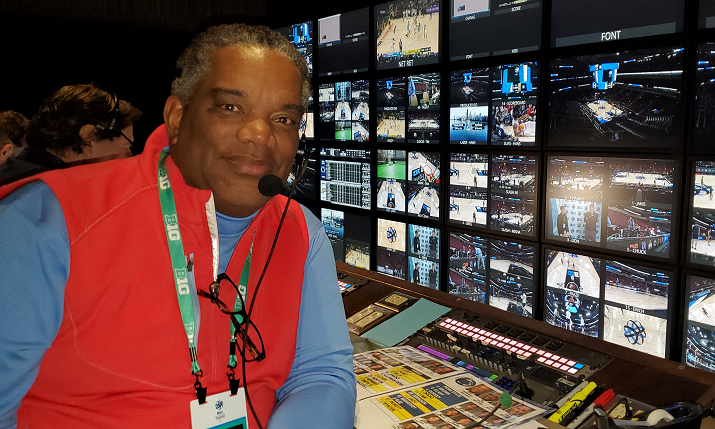Live from the Final Four: A roundup of broadcast innovation at the US college basketball event

More than 60 cameras, including this jib, fill NRG Stadium for game and studio coverage of the 2023 NCAA Men’s Basketball Final Four on CBS. (Photo: Kristian Hernandez, SVG)
March Madness is one of the most anticipated and watched events in the US, as well as being a breeding ground for technology and sports broadcast innovation.
The National Collegiate Athletic Association (NCAA) Division I men’s basketball tournament – branded ‘March Madness’ since the 1980s – is a tournament to determine the men’s college basketball national champion.
Having started out with 68 teams last month, the ‘Final Four’ penultimate round took place on Saturday with the culmination of the tournament taking place tonight (Monday 3 April), when UConn will take on San Diego State in the Championship match at the NRG Stadium in Houston, Texas.
CBS Sports and Warner Bros. Discovery Sports have been providing live coverage of the matches across four national television networks – TBS, CBS, TNT and truTV – with all games streamed on NCAA March Madness Live in the US and streamed via ESPN Player in Europe.
Among some of the key production and operations highlights are the debut of a live drone flying inside NRG Stadium, the rollout of a new version of the RailCam system that sports two cameras instead of one, the move to Game Creek Video’s Encore mobile production unit as the main game truck, and a more comprehensive arsenal of super slow-mos and robotic camera systems.
“The [WBD Sports] team and our team at CBS, started really good, healthy discussions as early as September to talk about, not just the Final Four, but quite frankly all of March Madness,” says Jason Cohen, VP, Remote Technical Operations for CBS Sports.

CBS Sports and WBD Sports are debuting a new double-headed version of their RailCam system at the NCAA Men’s Basketball Final Four in Houston. (Photo: CBS Sports/WBD Sports)
This year, at the NCAA Men’s Basketball Final Four in Houston, the teams at CBS Sports and WBD Sports are debuting a new, two-headed version of the track system to offer more options to the production team.
The two cameras on the RailCam are a Sony P43 shooting at 6-time slow motion with a Canon CJ15ex8.5 BKRS-V S lens (with built-in stabiliser) – which pulls the traditional RailCam angle – and a Sony F55 with a Canon Cabrio 17-120 or a Canon 25-250 PL lens, which is tasked with shooting in shallow depth-of-field.
For the first time at the NCAA Men’s Basketball Final Four, a drone will fly inside the stadium and serve as a live camera angle for game coverage.
CBS Sports and Warner Bros. Discovery Sports partnered with the NCAA to get the drone – which is provided by the CNN Aerial Imagery and Reporting (CNN AIR) division – approved this week for flight inside the stadium in pre-designated areas.
It’s a significant step forward for CBS Sports and WBD Sports production and operations teams. Last year in New Orleans, they were able to use a drone but only for exterior scenic shots outside of the Caesars Superdome.

A drone will fly both inside and outside NRG Stadium offering live visuals for game and studio coverage at the NCAA Men’s Basketball Final Four in Houston this weekend. (Photo: CBS Sports/WBD Sports)
“The goal is to just go inch-by-inch and to continue to grow,” says Chris Brown, VP, Production Operations and Technology for WBD Sports. “We were able to take what we were able to do last year, learn from it, and work with the NCAA to move it just a little bit more forward.”
And, for the first time in the 40-year history of the NCAA Men’s Basketball Tournament on CBS Sports, a new man was sat in the director’s chair for the Final Four and he will also be calling the shots for the National Championship Game.
Mark Grant, a five-time Emmy Award-winner and veteran shot-caller of NFL, college football, college basketball, and golf, takes on the role, succeeding Bob Fishman, a Sports Broadcasting Hall of Famer who hung up his headset a year ago.

Mark Grant directed his first NCAA Men’s Basketball Final Four on Saturday. (Photos: CBS Sports)
“Sometimes the best cut is no cut at all,” says Grant. “The best shot is staying on the camera that is play-by-play. I’ve painted myself in a corner many times, being too aggressive, cutting to the hero [shot] on a made basket and they steal the inbounds pass or someone steps on the line bringing the ball in. You miss that moment because you’re so busy trying to cut shots.”
Asked about the host of specialty cameras and ‘bells and whistles’ available to him, Grant says: “Whenever you have a game that has some aerial presence, whether that’s a SkyCam, or a drone, or a blimp, or a fixed-wing, it really puts that show on the map. It makes it bigger and it’s really cool to have that. At the [game] level I work at doing NFL, I don’t always have that. So when I get the chance, it’s great.
“Those shallow depth-of-field cameras are great. We’re going to have two of them here at the Final Four. We’re going to have the a double-headed RailCam: one as a traditional camera and the other shooting in that shallow depth-of-field look. We want to see what that brings.”
Additional reporting by Kristian Hernandez
In-depth: All the SVG coverage of the Men’s Final Four
- Live From Men’s Final Four: CBS Sports, WBD Sports Continue to Innovate With Big Show in Houston
- Live From Men’s Final Four: Double-Headed RailCam Debuts For CBS Sports, WBD Sports
- Live From Men’s Final Four: A Live Drone Flies Inside NRG Stadium For Game Coverage
- Live From Men’s Final Four: CBS Sports Director Mark Grant Gets His Shot In the Chair After 40+ Years In The Industry
- Live From Men’s Final Four: Game Creek Video Swaps Out 79 for Encore as Main Game Production Truck
- Live From Men’s Final Four: ACC Network Dances the Texas Two-Step With Studio Programming in Houston, Dallas
- Live From Men’s Final Four: Mountain West Conference’s Jesse Kurtz on Seizing the Moment Through Storytelling
- Live From Men’s Final Four: Van Wagner’s Ryan Kehn, Daniel Zerunyan on Working in the Houston Livestock Show and Rodeo Control Room
- Live From Men’s Final Four: FAU’s Evan Shomo on Cherishing the Moment of This Cinderella Tournament Run
- Live From Men’s Final Four: UConn’s Jason Reider and David Kaplan on the Value of Preparation in Content Creation
- Live From Men’s Final Four: University of Miami’s Tessa Mortensen on Representing the 305, Writing Program History With the Women’s Team
- Live From Men’s Final Four: San Diego State University’s Jason Bott on Documenting Program History in Real-Time

